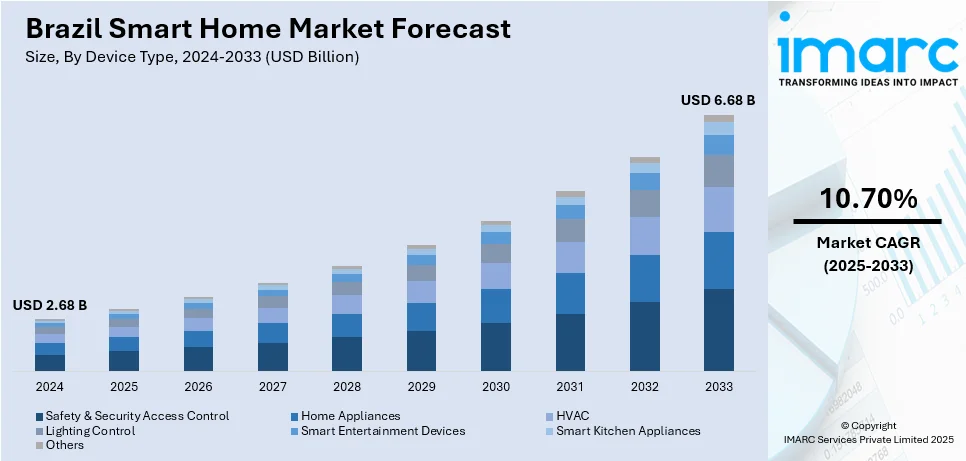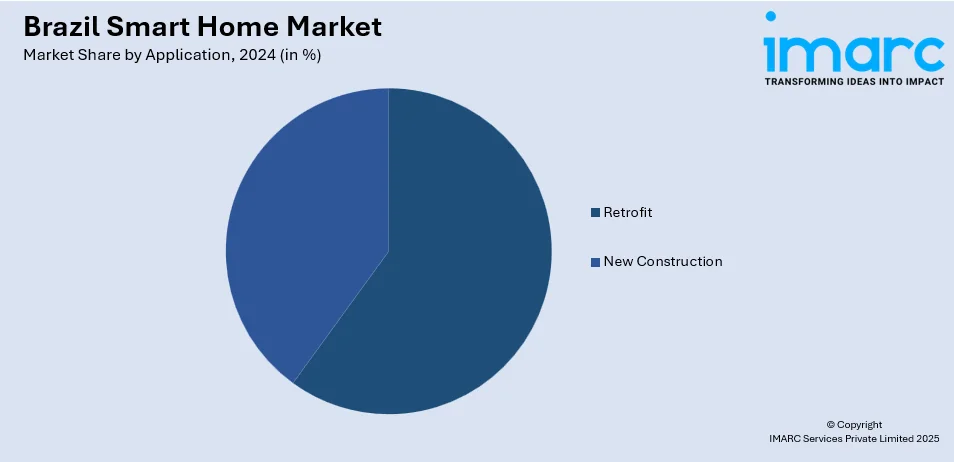
Brazil Smart Home Market Size, Share, Trends and Forecast by Device Type, Application, Protocol and Region, 2025-2033
Brazil Smart Home Market Overview:
The Brazil smart home market size reached USD 2.68 Billion in 2024. Looking forward, IMARC Group expects the market to reach USD 6.68 Billion by 2033, exhibiting a growth rate (CAGR) of 10.70% during 2025-2033. The increasing usage of IoT and connectivity technologies, increasing disposable incomes of the middle-class population, growing emphasis on energy efficiency and sustainability, increasing urbanization and smart city projects, growing demand for home security and automation is augmenting the Brazil smart home market share.
|
Report Attribute
|
Key Statistics
|
|---|---|
|
Base Year
|
2024
|
|
Forecast Years
|
2025-2033
|
|
Historical Years
|
2019-2024
|
| Market Size in 2024 | USD 2.68 Billion |
| Market Forecast in 2033 | USD 6.68 Billion |
| Market Growth Rate 2025-2033 | 10.70% |
Brazil Smart Home Market Trends:
Growing Adoption of IoT and Connectivity Technologies
The increasing adoption of Internet of Things (IoT) and connectivity technologies is a key driver for the growth of the Brazil smart home market. As per Brazilian Association of Internet Things (ABIMC) and ISG Provider, the number of devices that are connected in Brazil will touch 27.1 billion by 2025. With growing connectivity of appliances and devices, Brazilian consumers find themselves drawn towards the convenience and efficiency offered through smart homes. IoT enables remote control of various home appliances like lights, thermostats, security systems, and appliances through smartphones or voice assistants. Consumers can schedule their daily activities, monitor energy consumption, and optimize home management. In addition, the growth in high-speed internet penetration in urban and rural regions has also fueled the demand for smart home products.

Increasing Demand for Energy-Efficient Solutions
One of the most important driving factors for the Brazil smart home market is growing demand for energy-efficient solutions. According to the International Trade Association (ITA), Brazil's renewable energy sector maintains 83% of the country's electricity matrix. With soaring energy prices and a greater emphasis on sustainability, homeowners in Brazil are increasingly opting for smart home devices that curb energy usage and minimize utility expenses. Smart thermostats, lighting control systems, and energy management appliances are gaining popularity because they allow users to see energy consumption and control it in real time, leading to improved control of energy consumption in homes. The Government of Brazil has also been interested in energy efficiency in other sectors besides industrial units, including domestic houses. A number of incentives like tax relief and rebates have been put in place to induce the use of energy-saving technologies. As a part of worldwide initiatives towards the mitigation of carbon emissions and the slowdown of climate change, Brazil is striving to curtail its environmental impact. Smart home devices, which endorse eco-friendly habits, are in harmony with this objective and gaining increased momentum among sustainable consumers, which in turn is favorably affecting Brazil smart home market outlook.
Increasing Urbanization and Smart City Initiatives
Another key driver of the smart home market is the rapid urbanization in Brazil. According to the Data World Bank, as of 2023, 88% of the Brazilian population resides in urbanized locations. As the urban population increases, there is a rising need for contemporary, technology-equipped housing options. Cities generally have better infrastructure such as strong broadband and electrical systems to accommodate smart home technologies. Due to the high concentration of individuals in urban areas in Brazil, particularly in megacities such as São Paulo and Rio de Janeiro, there is a stronger interest and need for smart home technology. In addition, Brazil has been putting resources into smart city projects. Cities are integrating high-tech solutions into public services in order to establish more streamlined, interconnected environments. This trend matches the integration of smart home devices, as individuals grow more familiar with using technology in their daily routines.
Brazil Smart Home Market Segmentation:
IMARC Group provides an analysis of the key trends in each segment of the market, along with forecasts at the country level for 2025-2033. Our report has categorized the market based on device type, application and protocol.
Device Type Insights:
- Safety & Security Access Control
- Security Cameras
- Smart Door Locks
- Remote Monitoring Software & Services
- Home Appliances
- Smart Water Heaters
- Smart Washing Machines
- Smart Vacuum Cleaners
- HVAC
- Smart Thermostats
- Sensors
- Smart Vents
- Heating & Cooling Coils
- Others
- Lighting Control
- Smart Lights
- Dimmers
- Occupancy Sensors
- Switches
- Others
- Smart Entertainment Devices
- Smart Displays/TV
- Sound Bars & Speakers
- Others
- Smart Kitchen Appliances
- Refrigerators
- Dish Washers
- Microwave/Ovens
- Others
- Others
The report has provided a detailed breakup and analysis of the market based on the device type. This includes safety and security access control (security cameras, smart door locks, and remote monitoring software & services), home appliances (smart water heaters, smart washing machines, and smart vacuum cleaners), HVAC (smart thermostats, sensors, smart vents, heating and cooling coils, and others), lighting control (smart lights, dimmers, occupancy sensors, switches, and others), smart entertainment devices (smart displays/TVs, sound bars and speakers, and others), smart kitchen appliances (refrigerators, dishwashers, microwave/ovens, and others), and others.
Application Insights:

- Retrofit
- New Construction
A detailed breakup and analysis of the market based on the application have also been provided in the report. This includes retrofit and new construction.
Protocol Insights:
- Wired
- Non-Wired
A detailed breakup and analysis of the market based on the protocol have also been provided in the report. This includes wired and non-wired.
Regional Insights:
- Southeast
- South
- Northeast
- North
- Central-West
The report has also provided a comprehensive analysis of all the major regional markets, which include Southeast, South, Northeast, North, and Central-West.
Competitive Landscape:
The market research report has also provided a comprehensive analysis of the competitive landscape. Competitive analysis such as market structure, key player positioning, top winning strategies, competitive dashboard, and company evaluation quadrant has been covered in the report. Also, detailed profiles of all major companies have been provided.
Brazil Smart Home Market News:
- 25 June 2024: Tuya Smart, a cloud platform service provider and Hometree Casa Inteligente LTDA (a smart home service provider in Brazil) have partnered to develop cutting-edge smart whole-house solutions aimed at revolutionizing traditional living spaces in Brazil. Hometree Casa Inteligente LTDA has pioneered wireless home automation solutions in Brazil, leveraging a franchise model with 14 agents across 14 regions to provide seamless and intuitive smart home living experiences.
Brazil Smart Home Market Report Coverage:
| Report Features | Details |
|---|---|
| Base Year of the Analysis | 2024 |
| Historical Period | 2019-2024 |
| Forecast Period | 2025-2033 |
| Units | Billion USD |
| Scope of the Report | Exploration of Historical Trends and Market Outlook, Industry Catalysts and Challenges, Segment-Wise Historical and Future Market Assessment:
|
| Device Types Covered |
|
| Applications Covered | Retrofit, New Construction |
| Protocols Covered | Wired, Wireless |
| Regions Covered | Southeast, South, Northeast, North, Central West |
| Customization Scope | 10% Free Customization |
| Post-Sale Analyst Support | 10-12 Weeks |
| Delivery Format | PDF and Excel through Email (We can also provide the editable version of the report in PPT/Word format on special request) |
Key Questions Answered in This Report:
- How has the Brazil smart home market performed so far and how will it perform in the coming years?
- What is the breakup of the Brazil smart home market on the basis of device type?
- What is the breakup of the Brazil smart home market on the basis of application?
- What is the breakup of the Brazil smart home market on the basis of protocol?
- What is the breakup of the Brazil smart home market on the basis of region?
- What are the various stages in the value chain of the Brazil smart home market?
- What are the key driving factors and challenges in the Brazil smart home?
- What is the structure of the Brazil smart home market and who are the key players?
- What is the degree of competition in the Brazil smart home market?
Key Benefits for Stakeholders:
- IMARC’s industry report offers a comprehensive quantitative analysis of various market segments, historical and current market trends, market forecasts, and dynamics of the Brazil smart home market from 2019-2033.
- The research report provides the latest information on the market drivers, challenges, and opportunities in the Brazil smart home market.
- Porter's five forces analysis assist stakeholders in assessing the impact of new entrants, competitive rivalry, supplier power, buyer power, and the threat of substitution. It helps stakeholders to analyze the level of competition within the Brazil smart home industry and its attractiveness.
- Competitive landscape allows stakeholders to understand their competitive environment and provides an insight into the current positions of key players in the market.
Need more help?
- Speak to our experienced analysts for insights on the current market scenarios.
- Include additional segments and countries to customize the report as per your requirement.
- Gain an unparalleled competitive advantage in your domain by understanding how to utilize the report and positively impacting your operations and revenue.
- For further assistance, please connect with our analysts.
 Inquire Before Buying
Inquire Before Buying
 Speak to an Analyst
Speak to an Analyst
 Request Brochure
Request Brochure
 Request Customization
Request Customization




.webp)




.webp)












